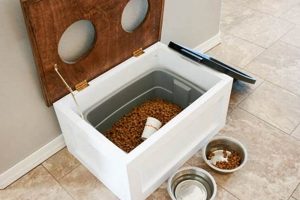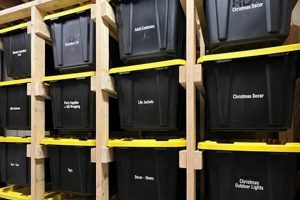A self-assembled reservoir for potable or non-potable liquid is a structure created using readily available materials and techniques by an individual or group for the purpose of holding water. These constructions range from simple repurposed containers to more complex, engineered systems. For example, a homeowner might connect multiple food-grade plastic drums to create a supplementary water supply for irrigation.
Such constructed systems can offer several advantages, including increased water security, reduced reliance on municipal supplies, and potential cost savings. Historically, individuals and communities have implemented similar solutions to manage water resources in areas with limited infrastructure or during periods of drought. Their use enables greater control over water access and promotes sustainable water management practices on a smaller scale.
The following sections will explore various aspects involved in the construction of these systems, from material selection and site preparation to assembly techniques and safety considerations. It is important to consider all factors to build a suitable system.
Essential Guidelines for Self-Assembled Water Reservoirs
The successful construction of a water storage system requires meticulous planning and execution. Following the guidelines detailed below will contribute to a durable, safe, and effective water storage solution.
Tip 1: Material Selection: Employ only food-grade or potable-water-safe materials to prevent contamination. Polyethylene and polypropylene are commonly used plastics that meet these requirements. Avoid repurposed containers that previously held chemicals or other potentially harmful substances.
Tip 2: Site Assessment: Choose a level, stable location for the reservoir. Consider factors such as soil composition, proximity to water sources, and potential for flooding or landslides. A reinforced concrete pad may be necessary to provide a solid foundation.
Tip 3: Capacity Calculation: Accurately estimate the required storage volume based on water usage patterns and anticipated needs. Overestimation is preferable to underestimation to ensure an adequate water supply during periods of low rainfall or high demand.
Tip 4: Proper Sealing: Ensure all connections and seams are watertight using appropriate sealants and fittings. Regular inspection and maintenance are crucial to prevent leaks and minimize water loss.
Tip 5: Inlet/Outlet Design: Design the inlet and outlet to prevent sediment accumulation and facilitate easy cleaning. A filtration system installed at the inlet can remove debris and improve water quality.
Tip 6: Algae Control: Prevent algae growth by using opaque containers or covering transparent tanks. Regular cleaning and disinfection are also necessary to maintain water quality.
Tip 7: Overflow Mechanism: Incorporate an overflow mechanism to prevent overfilling and potential structural damage. The overflow outlet should be directed away from the foundation and other sensitive areas.
Tip 8: Structural Integrity: Ensure the reservoir’s structural integrity by following established engineering principles and guidelines. Reinforce the structure as necessary to withstand the weight of the water and external forces.
Adherence to these guidelines will maximize the lifespan and effectiveness of the self-assembled water reservoir, contributing to a reliable water supply.
The next section will delve into more specific considerations, like legal requirements and the importance of understanding local building codes.
1. Material Selection
The choice of materials in constructing a water storage system fundamentally dictates the system’s suitability for its intended purpose and its overall lifespan. A direct causal relationship exists between material selection and water quality: inappropriate materials can leach contaminants into the stored water, rendering it unsafe for consumption or irrigation. For instance, using repurposed industrial drums without proper cleaning and relining can introduce harmful chemicals into the water supply. The consequences range from mild gastrointestinal distress to severe health complications, depending on the contaminants present and the duration of exposure.
Furthermore, material selection directly affects the structural integrity of the reservoir. Choosing materials lacking sufficient strength or durability will lead to premature failure of the system, potentially resulting in significant water loss and property damage. Consider the scenario of using untreated wood for a large-capacity tank; the wood will inevitably rot and degrade over time, causing leaks and eventually, structural collapse. Conversely, selecting UV-resistant, food-grade polyethylene ensures both water safety and long-term structural stability.
Understanding the implications of material selection is critical for anyone undertaking the construction of a water storage system. A thorough assessment of material properties, compatibility with water, and resistance to environmental factors is essential. Prioritizing certified, potable-water-safe materials and adhering to established engineering guidelines will contribute to a safe, reliable, and sustainable water storage solution. This critical understanding mitigates the risks associated with contamination and structural failure, ultimately safeguarding both the water supply and the investment in the system.
2. Structural Integrity
The structural integrity of a self-constructed water reservoir is paramount, representing the linchpin of the system’s functionality and safety. Compromised structural stability can lead to catastrophic failure, resulting in significant water loss, property damage, and potential safety hazards. The cause-and-effect relationship is direct: inadequate design or construction practices inevitably lead to weakened structures susceptible to pressure, environmental factors, and the sheer weight of the stored water. For example, a tank built without proper reinforcement or support can buckle under the hydrostatic pressure, leading to a rupture and sudden release of the stored water. This highlights that structural integrity is not merely a desirable feature, but a core requirement for a functional and safe system.
Considering real-life examples further emphasizes the critical role of structural soundness. The collapse of inadequately built water tanks, particularly in rural or underserved communities, underscores the potentially devastating consequences of neglecting structural integrity. These failures often result from using substandard materials, neglecting proper load calculations, or failing to account for local environmental conditions like seismic activity or extreme temperature fluctuations. Proper engineering principles, rigorous testing, and adherence to building codes are necessary to mitigate these risks. This includes considering factors such as tank geometry, wall thickness, and reinforcement strategies. For example, cylindrical tanks are generally more structurally sound than rectangular tanks due to their ability to distribute pressure more evenly. Reinforcing materials, such as steel bands or mesh, are often necessary to enhance the tank’s resistance to bursting forces.
In summary, structural integrity is non-negotiable in the context of diy water storage tank systems. A thorough understanding of engineering principles, careful material selection, and meticulous construction practices are essential to ensure a safe, reliable, and long-lasting water storage solution. The challenges in maintaining structural integrity underscore the importance of thorough planning, adherence to proven building techniques, and regular inspection to detect and address potential weaknesses before they escalate into serious problems. A focus on this crucial component significantly contributes to the sustainability and safety of these constructed systems.
3. Water Quality
Water quality within self-constructed storage systems is a critical determinant of the stored water’s suitability for its intended purpose. Compromised water quality presents risks ranging from aesthetic concerns to serious health hazards. Therefore, meticulous attention to factors influencing water quality is essential throughout the construction and maintenance of these systems.
- Material Composition and Leachates
The materials used in the reservoir’s construction directly impact water quality. Non-food-grade plastics or untreated metals can leach harmful chemicals into the water supply, rendering it unsafe for human consumption. For instance, PVC pipes contain plasticizers that can dissolve into water over time, posing potential health risks. Selecting certified, potable-water-safe materials like polyethylene or stainless steel is essential to prevent contamination.
- Environmental Contamination
The surrounding environment can introduce contaminants into the storage system. Runoff from agricultural areas can carry pesticides and fertilizers, while airborne pollutants can settle on the water surface. Proper sealing and filtration are necessary to minimize environmental contamination. An example is the implementation of a tightly sealed lid and a first-flush diverter to prevent initial contaminated runoff from entering the main storage volume.
- Biological Growth
Stagnant water provides a breeding ground for bacteria, algae, and other microorganisms. These organisms can degrade water quality, causing unpleasant tastes and odors, and in some cases, posing health risks. Algae blooms, for example, can release toxins that are harmful to humans and animals. Preventing light penetration through opaque containers or covers and implementing regular cleaning and disinfection protocols are crucial for controlling biological growth.
- Sediment Accumulation
Sediment, including silt, sand, and organic matter, can accumulate in the storage tank over time, reducing its effective capacity and providing a substrate for microbial growth. An inlet filter helps prevent sediment from entering the system. Regular flushing and cleaning are necessary to remove accumulated sediment and maintain water quality.
These facets, when considered holistically, underscore the importance of integrating water quality considerations into every stage of planning, construction, and maintenance of self-constructed water storage. Adhering to best practices minimizes risks, maintains water potability, and maximizes the longevity and usefulness of the water storage system.
4. Capacity Planning
Capacity planning is fundamentally linked to the effective implementation of diy water storage tank systems. The core connection lies in the ability of the system to meet present and future water demands. Inadequate capacity planning results in water shortages, undermining the very purpose of the storage tank. Conversely, excessive capacity can lead to wasted resources, increased costs, and potential water stagnation issues that compromise water quality.
Several practical examples underscore this relationship. Consider a rural household relying on rainwater harvesting. If the storage tank capacity is based solely on average monthly rainfall without accounting for prolonged dry periods or increased water usage during peak seasons (e.g., gardening or livestock watering), the family may experience water scarcity. A more comprehensive capacity planning approach would analyze historical rainfall data, projected water consumption patterns, and the potential for supplemental water sources to determine the optimal tank size. The effect would be a more reliable and sustainable water supply. Another example arises with water storage for fire suppression. In this application, capacity must be determined by local fire code requirements and the specific hazards of the property, not just perceived need.
In conclusion, capacity planning is a crucial aspect for effective diy water storage tanks. The challenges in accurate planning stem from unpredictable weather patterns and variations in water demand. By adopting a data-driven approach, utilizing historical records, projecting future needs, and considering local regulations, one can mitigate the risks of water scarcity or inefficiency. The understanding and execution of meticulous capacity planning are paramount to maximizing the benefits and overall utility of water storage tank systems, ensuring their long-term sustainability and the reliable provision of water resources.
5. Code Compliance
Code compliance is an indispensable aspect of self-constructed water storage systems. It guarantees the system’s safety, legality, and integration with existing infrastructure. Failure to adhere to relevant building codes and regulations can result in severe consequences, ranging from financial penalties and forced system removal to potential health risks and environmental damage. The correlation is direct: neglecting code compliance creates vulnerabilities that compromise the safety and longevity of the water storage solution.
The importance of code compliance is illustrated through multiple examples. Local building codes often dictate specific requirements for tank materials, structural design, and plumbing connections. For instance, potable water storage tanks may need to be constructed from NSF-certified materials to prevent contamination, or require backflow prevention devices in connections to municipal water supplies. Ignoring these stipulations can lead to contamination of the water supply or create a hazard for the municipal water system. Likewise, structural codes define standards for foundation stability and tank wall thickness, ensuring the reservoir can withstand hydrostatic pressure and environmental loads, such as wind or seismic activity. Non-compliance can cause structural failure with potential collateral damage.
In conclusion, code compliance is a foundational element in self-constructed water containment systems. The potential challenges associated with staying abreast of frequently evolving regulations emphasize the need for thorough investigation of local, state, and federal requirements. Consulting with licensed engineers, building inspectors, and plumbing professionals is advisable. Adhering to relevant codes ensures the system functions safely and effectively and is fully compliant. Upholding code standards guarantees longevity, prevents hazards, and maximizes the usefulness of diy water storage tank projects, ensuring the safety and legality of the water storage solution.
Frequently Asked Questions
This section addresses common inquiries regarding the construction and maintenance of self-assembled water storage systems, providing clarity on best practices and essential considerations.
Question 1: What are the most suitable materials for constructing a reservoir intended for potable water?
Food-grade polyethylene and stainless steel are preferred choices due to their inert nature and resistance to leaching contaminants into the stored water. These materials are certified to meet NSF/ANSI standards for potable water contact.
Question 2: How is the appropriate size of a reservoir determined?
The required capacity depends on various factors, including water consumption patterns, rainfall data (for rainwater harvesting systems), and the intended use (e.g., irrigation, emergency supply). A thorough assessment of these factors is necessary to determine the optimal storage volume. In fire suppression contexts, it depends on regulations.
Question 3: What measures should be taken to prevent algae growth in a water storage tank?
Algae growth can be minimized by using opaque tanks or covers to block sunlight, implementing regular cleaning schedules, and considering the use of algaecides approved for potable water, if necessary. A filtration system is also recommended.
Question 4: How frequently should a self-assembled water reservoir be inspected and maintained?
Regular inspections, at least twice annually, are recommended to identify potential issues such as leaks, cracks, or contamination. Maintenance tasks, including cleaning and disinfection, should be performed as needed based on the inspection results.
Question 5: What safety precautions must be considered during the construction process?
Appropriate personal protective equipment (PPE), such as gloves and eye protection, should be worn at all times. Safe lifting techniques should be employed to prevent injuries, and any electrical work should be performed by a qualified electrician. Ensure the site is properly prepared to prevent hazards.
Question 6: Are there any legal considerations or permits required before constructing a water storage system?
Local building codes and regulations may require permits for water storage systems, particularly for larger installations. It is essential to consult with local authorities to ensure compliance with all applicable requirements. Also, there can be restrictions on diverting water that flows naturally.
Understanding these frequently asked questions is crucial for ensuring the safe and effective implementation of water storage solutions. Prioritize safety, compliance, and quality to guarantee the longevity and reliability of the diy water storage tank system.
The subsequent section will explore advanced techniques for water treatment and filtration, further enhancing the safety and potability of stored water.
Concluding Remarks on DIY Water Storage Tank Systems
The preceding analysis has explored the multifaceted nature of constructing a self-assembled water reservoir. From critical material choices impacting water potability to the imperative of structural integrity and code compliance, the discussion highlights the need for diligence and informed decision-making. Effective capacity planning, coupled with rigorous water quality maintenance, ensures the system fulfills its intended purpose of providing a reliable water source.
The construction of a diy water storage tank is not merely an exercise in assembling components but a commitment to responsible water management. As water scarcity intensifies and the demand for sustainable solutions grows, individuals and communities must approach these projects with a heightened awareness of their environmental and societal impact. A proactive stance, coupled with continued learning and adaptation, will secure a more resilient and sustainable water future.







